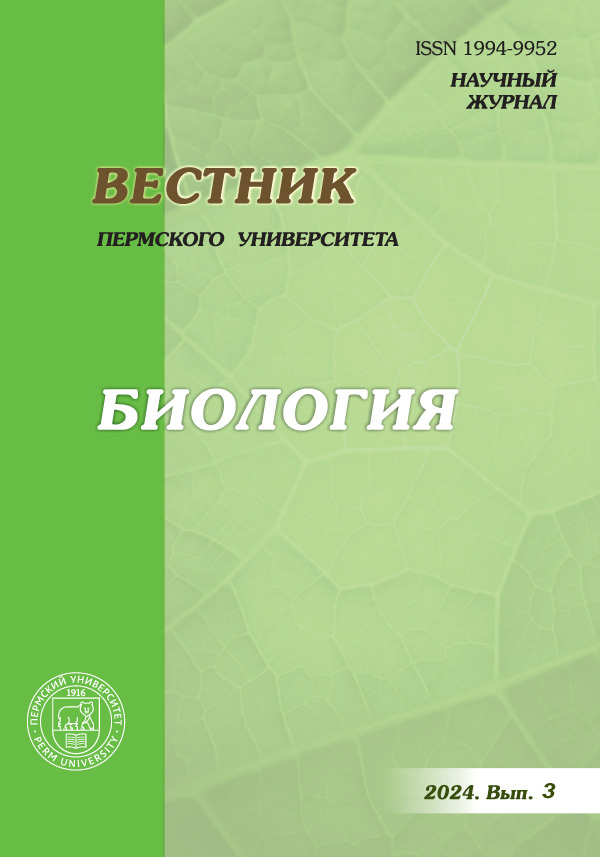Expression of some transcription factors CBF (C-REPEAT BINDING FACTOR) in rye seedlings (Secale cereale L.) under cold stress
Main Article Content
Abstract
Article Details
References
Бракк Д.Г. Продовольственная безопасность в условиях климатических трансформаций // Эконо-мическая безопасность. 2023. Т. 6, № 1. С. 367–384. DOI: 10.18334/ecsec.6.1.117557.
Ерастенкова М.В., Тихонова Н.Г., Ухатова Ю.В. Изучение молекулярных механизмов устойчивости винограда (Vitis vinifera L.) к низкотемпературному стрессу // Биотехнология и селекция растений. 2023. Т. 6, № 4. С. 48–60.
Кобяков А.С., Оразаева И.В. Хозяйственно-биологические признаки сортов и гибридов озимой ржи в условиях ЦЧР // Горинские чтения. Инновационные решения для АПК: материалы междунар. науч.-практ. студ. конф. Майский, 2021. С. 33.
Кузмицкая П.В., Королева Е.С., Урбанович О.Ю. Влияние некоторых абиотических факторов на профили экспрессии генов, кодирующих стресс-ассоциированные белки яблони // Известия Националь-ной академии наук Беларуси. Сер. биологических наук. 2024. Т. 69, № 2. С. 143–152.
Люсиков О.М. и др. Молекулярно-генетические аспекты устойчивости озимой пшеницы (Triticum L.) к низкотемпературному стрессу // Молекулярная и прикладная генетика. 2022. Т. 33. С. 137–150.
Мелешкина Е.П., Бундина О.И. Производство, переработка и потребление зерна ржи в России: направления развития // Пищевая промышленность. 2020. № 12. С. 55–59.
Пономарева М.Л. Современные реалии производства ржи и задачи селекционной науки // Гено-фонд и селекция растений: материалы сател. симпозиума V Междунар. конф. Новосибирск, 2020. С. 85–89.
Сизенцова Я.Г., Омельянчук Н.А., Миронова В.В. Мета-анализ данных транскриптомов выявил ге-ны-кандидаты устойчивости к низким положительным температурам у Arabidopsis thaliana L. // Биотех-нология в растениеводстве, животноводстве и сельскохозяйственной микробиологии: сб. тез. докл. 21-ой Всерос. молодеж. науч. конф. М., 2021. С. 12.
Трущелев А.Б. Селекция растений в условиях меняющегося климата // Балтийский морской форум: материалы VIII Междунар. Балт. мор. форума. Калининград, 2020. Т. 1. С. 156–160.
Федореева Л.И. и др. Сравнительная характеристика и адаптивные механизмы солеустойчивости у разных генотипов твердой и мягкой пшеницы // Сельскохозяйственная биология. 2023. Т. 58, № 3. С. 510–524.
Barah P. et al. Genome-scale cold stress response regulatory networks in ten Arabidopsis thaliana eco-types // BMC genomics. 2013. Vol. 14. P. 1–16.
Barrero-Gil J., Salinas J. Gene Regulatory Networks Mediating Cold Acclimation: The CBF Pathway // Iwaya-Inoue M., Sakurai M., Uemura M. (eds). Survival Strategies in Extreme Cold and Desiccation. Advances in Experimental Medicine and Biology. 2018. Vol. 1081. P. 3–22. https://doi.org/10.1007/978-981-13-1244-1_1.
Desrosiers C., Karypis G. A Comprehensive Survey of Neighborhood-Based Recommendation Methods. Recommender Systems Handbook. Springer, 2011. P. 107–144.
Caccialupi, G. et al. The Triticeae CBF Gene Cluster – To Frost Resistance and Beyond // Cells. 2023. Vol. 12, № 22. Art. 2606.
Chomczynski P., Sacchi N. Single-step method of RNA isolation by acid guanidinium thiocyanate-phenol-chloroform extraction // Analytical biochemistry. 1987. Vol. 162, № 1. P. 156–159.
Ghanbarian A.T., Hurst L.D. Neighboring genes show correlated evolution in gene expression // Molecular biology and evolution. 2015. Vol. 32, № 7. P. 1748–1766.
Jung W.J., Seo Y.W. Identification of novel C-repeat binding factor (CBF) genes in rye (Secale cereale L.) and expression studies // Gene. 2019. Vol. 684. P. 82–94.
Medina J. et al. The Arabidopsis CBF gene family is composed of three genes encoding AP2 domain-containing proteins whose expression is regulated by low temperature but not by abscisic acid or dehydration // Plant physiology. 1999. Vol. 119, № 2. P. 463–470.
Mizoi J., Shinozaki K., Yamaguchi-Shinozaki K. AP2/ERF family transcription factors in plant abiotic stress responses // Biochimica et Biophysica Acta. 2012. Vol. 1819(2). P. 86–96. DOI: 10.1016/j.bbagrm.2011.08.004.
Rao X. et al. An improvement of the 2^(-delta delta CT) method for quantitative real-time polymerase chain reaction data analysis // Biostat Bioinforma Biomath. 2013. Vol. 3, № 3. P. 71–85.
Wang D.Z. et al. Gene regulation and signal transduction in the ICE–CBF–COR signaling pathway during cold stress in plants // Biochemistry (Moscow). 2017. Vol. 82. P. 1103–1117. https://doi.org/10.1134/S0006297917100030.




